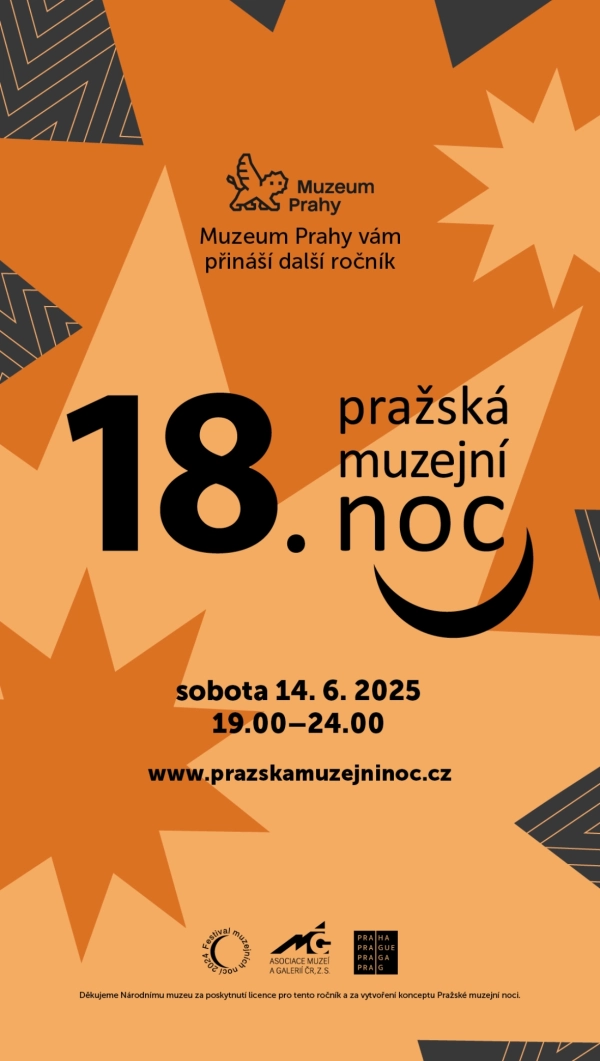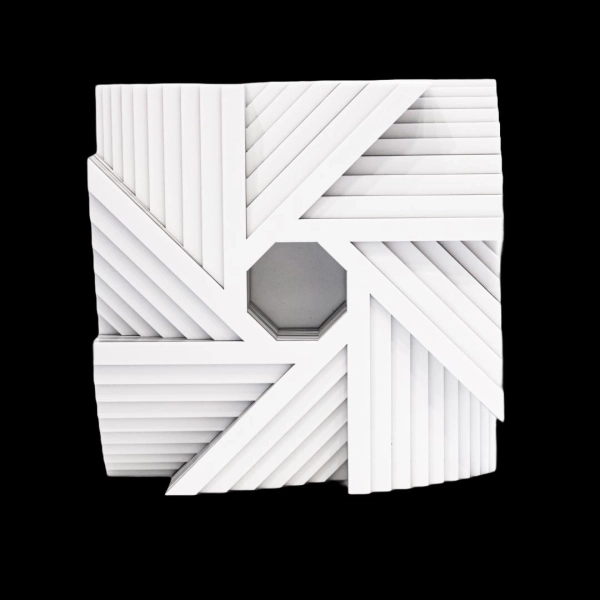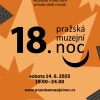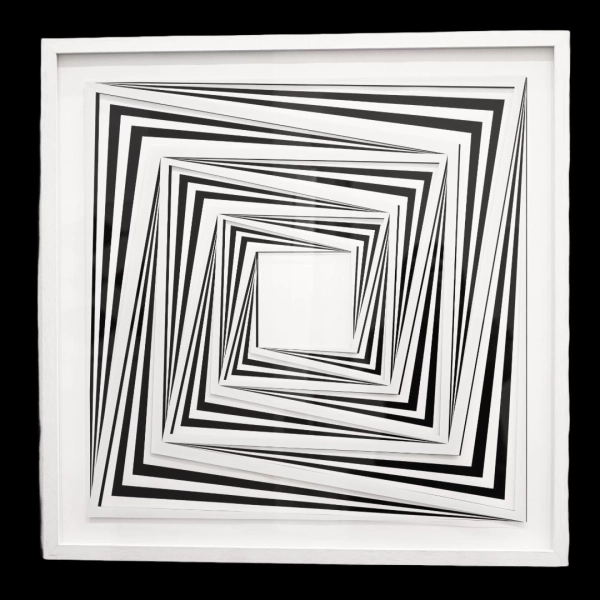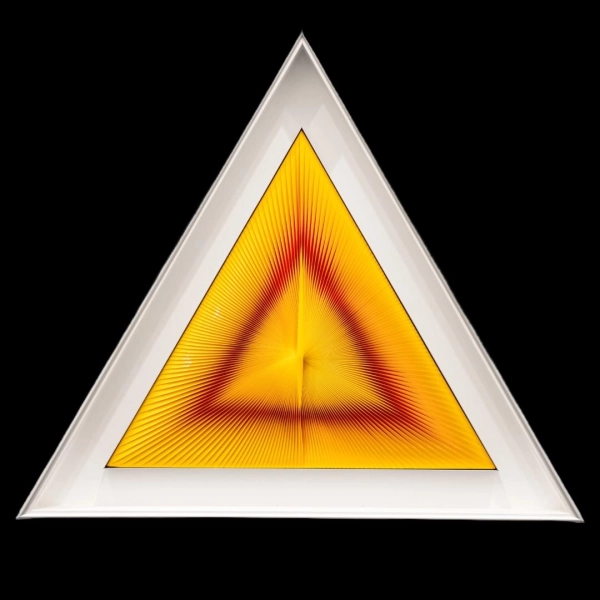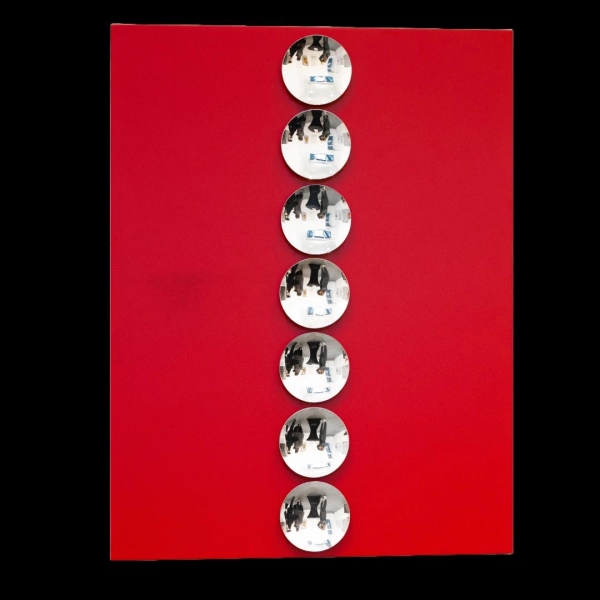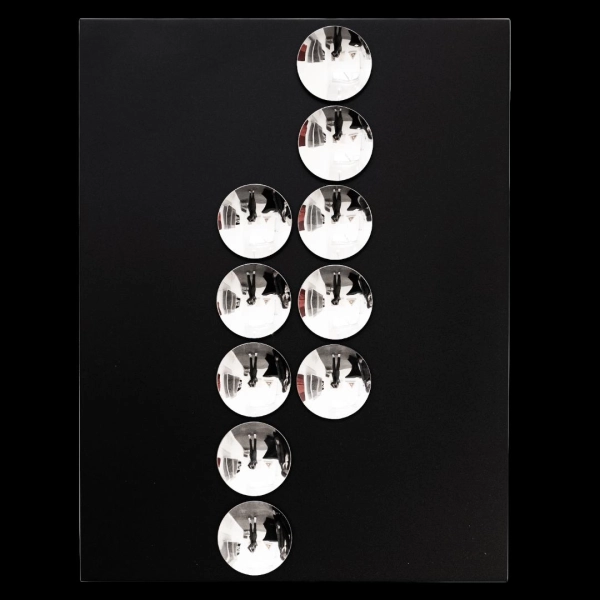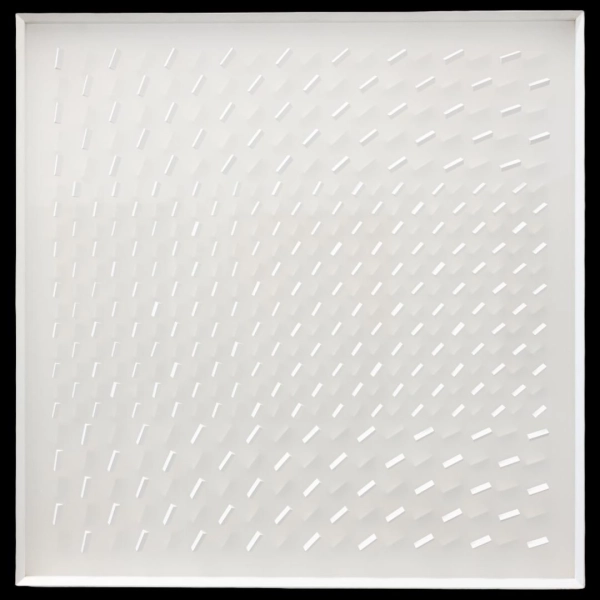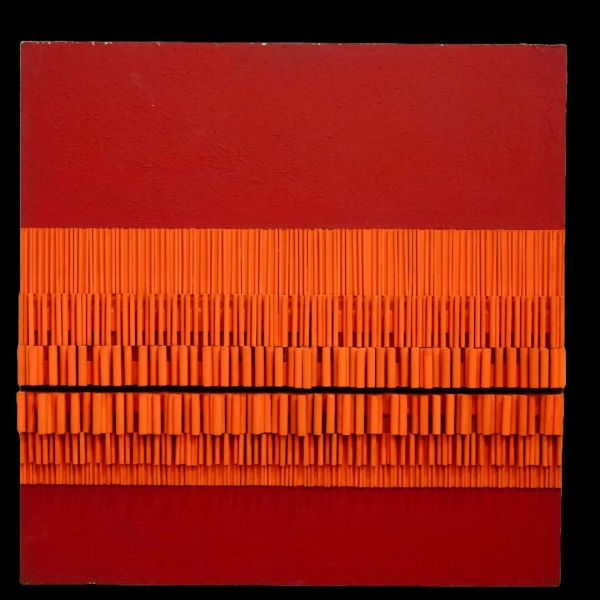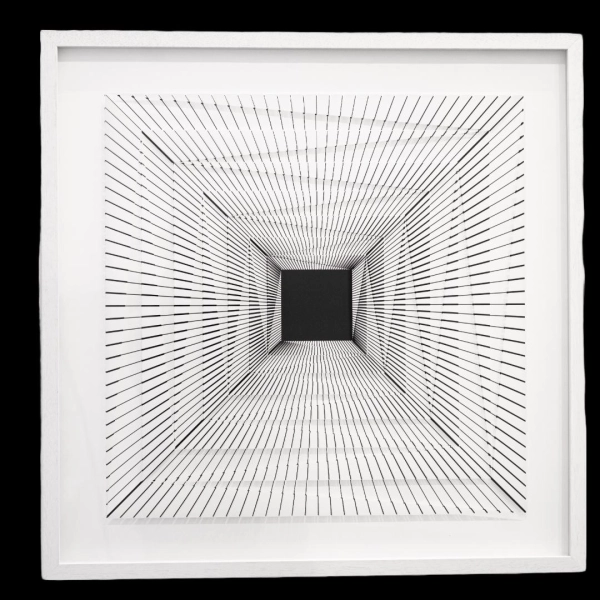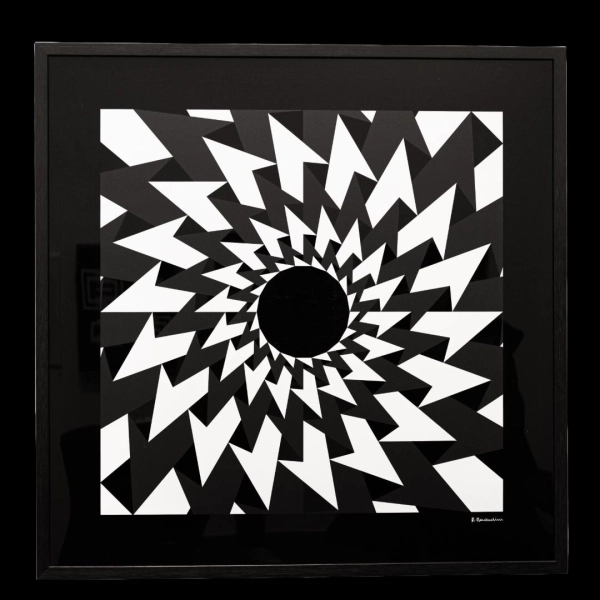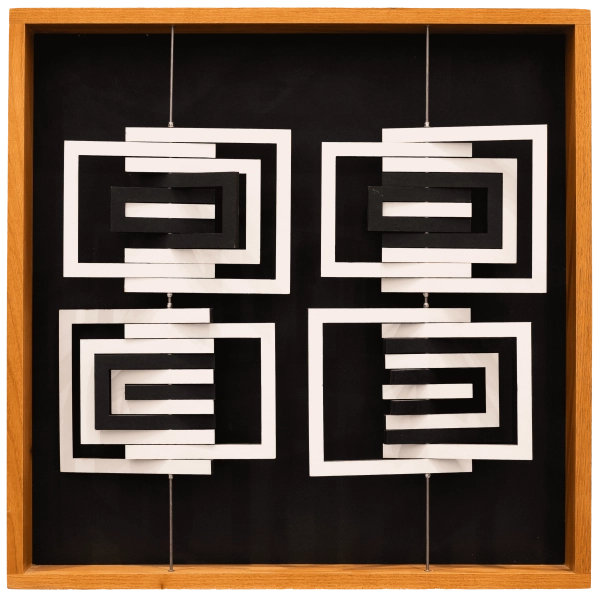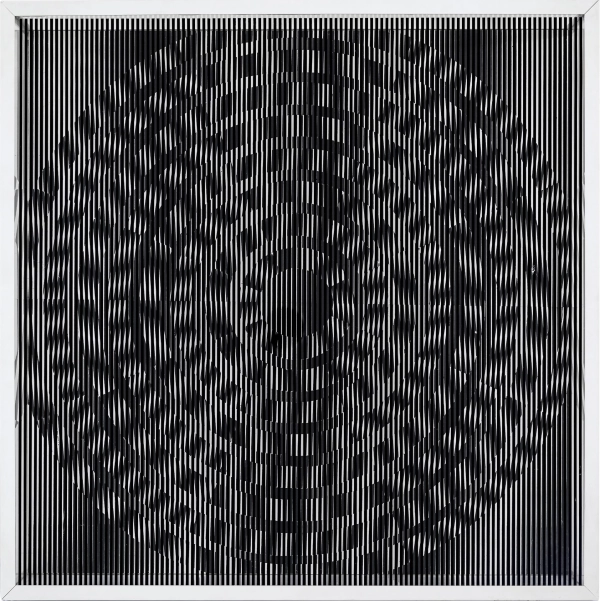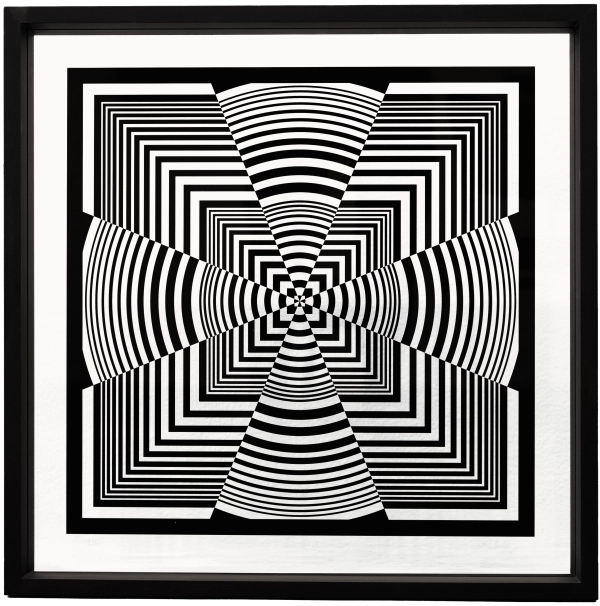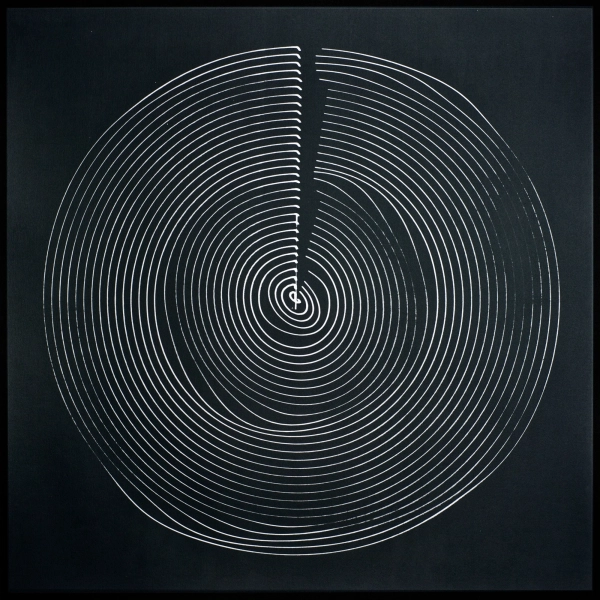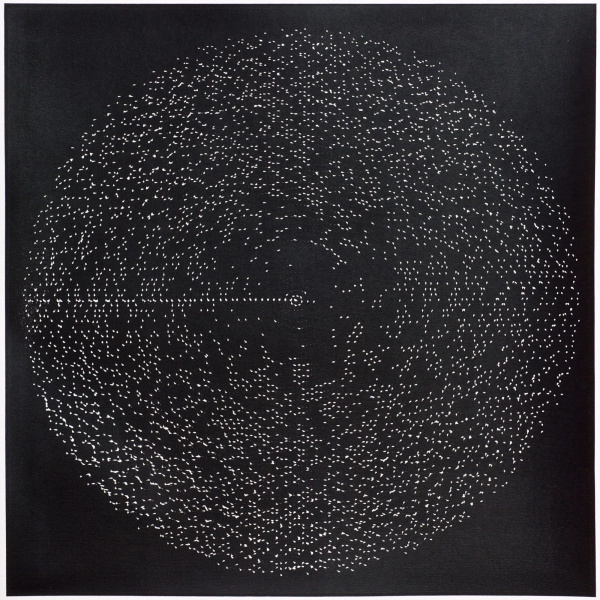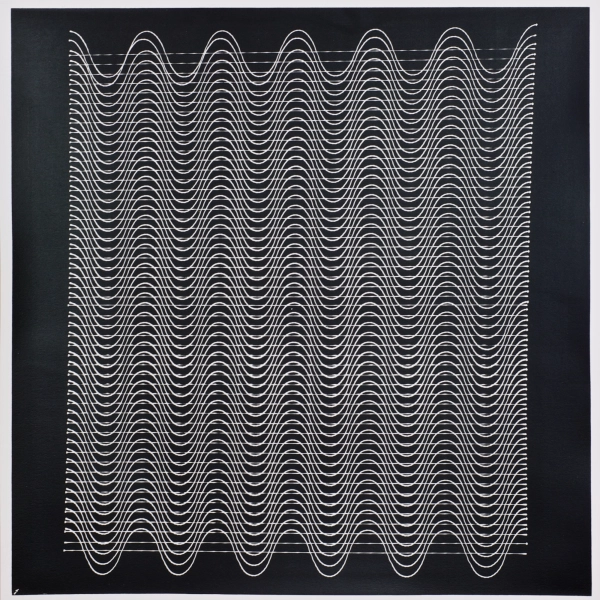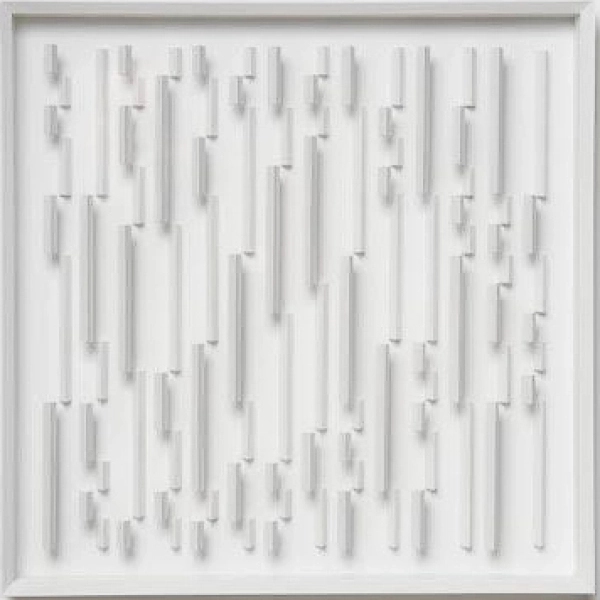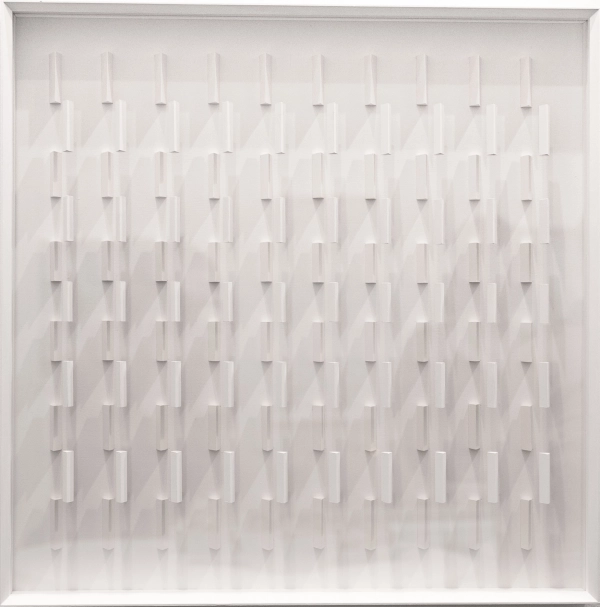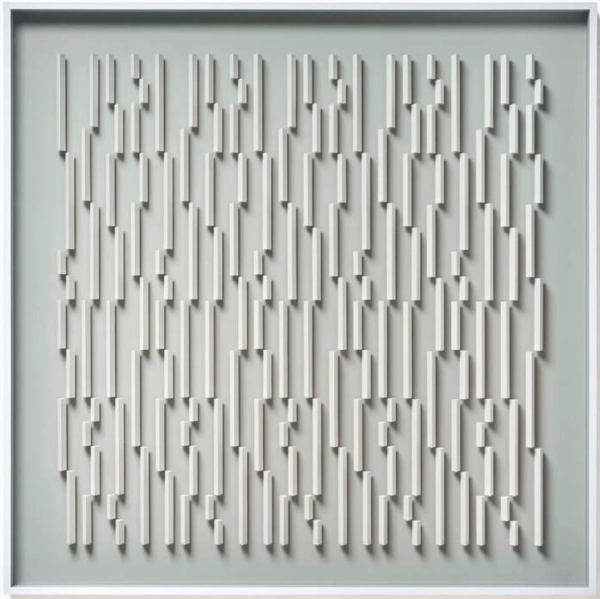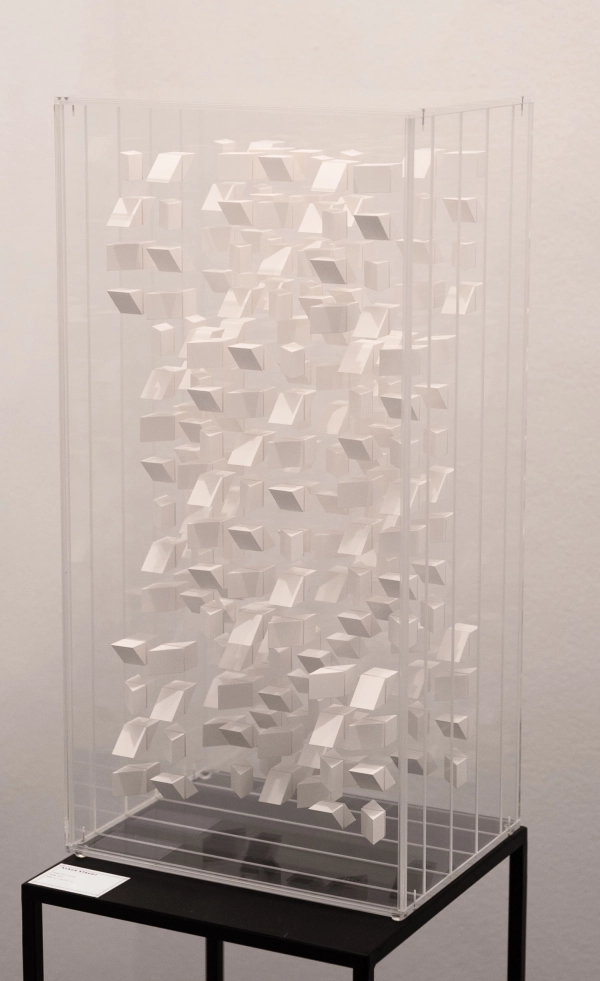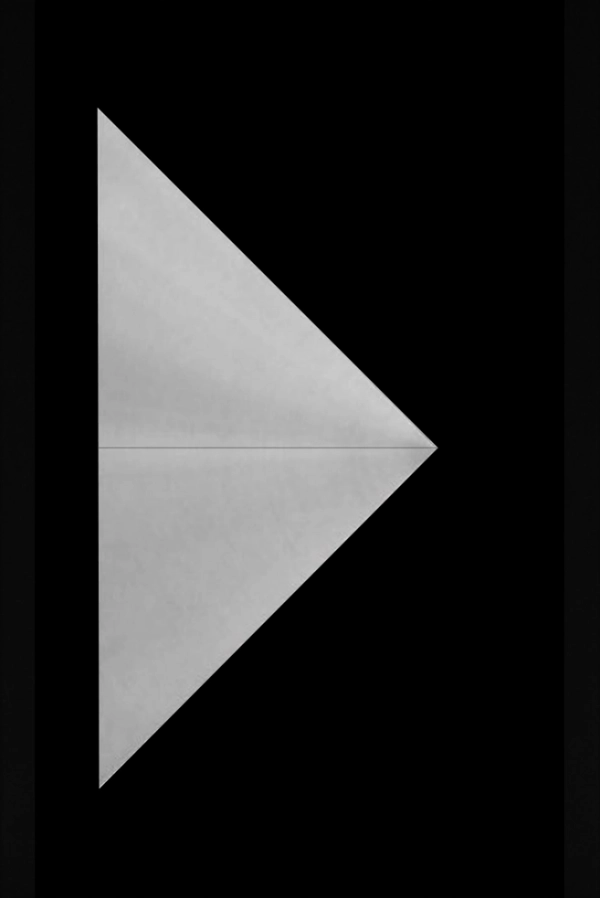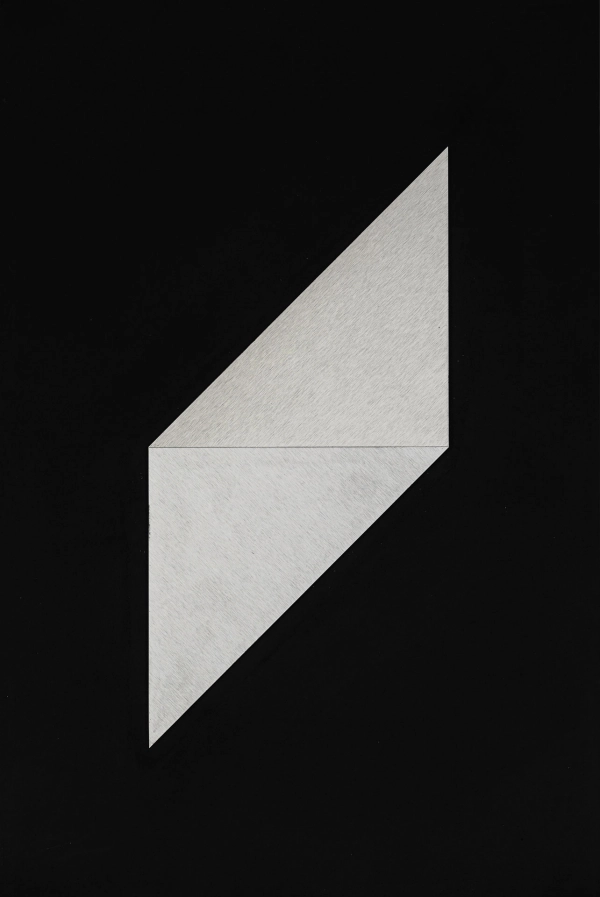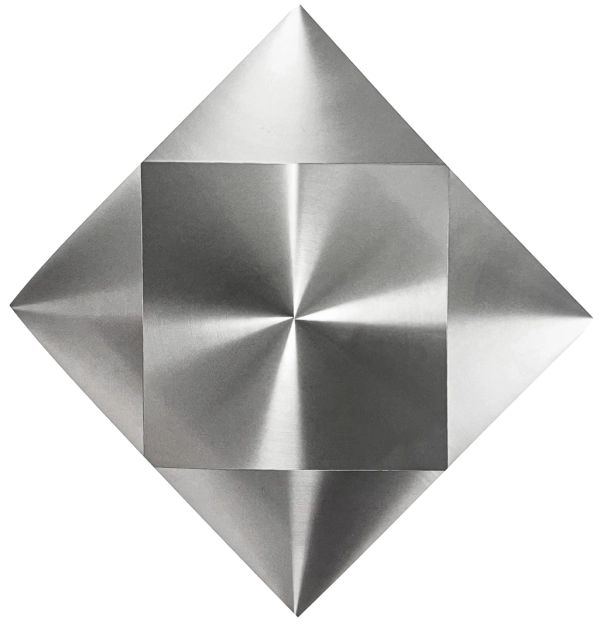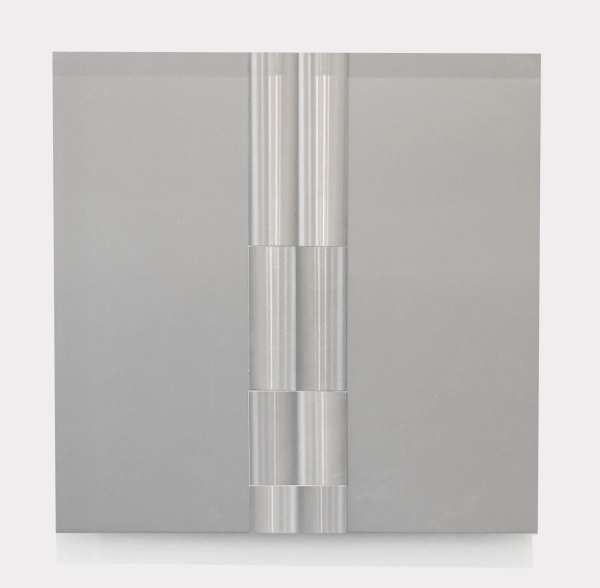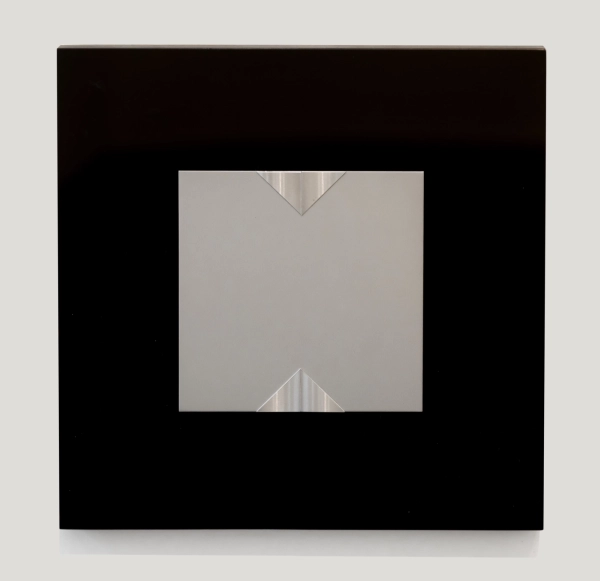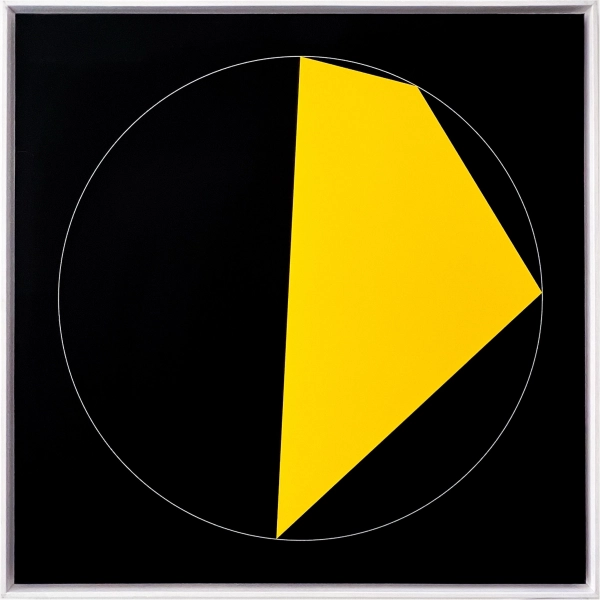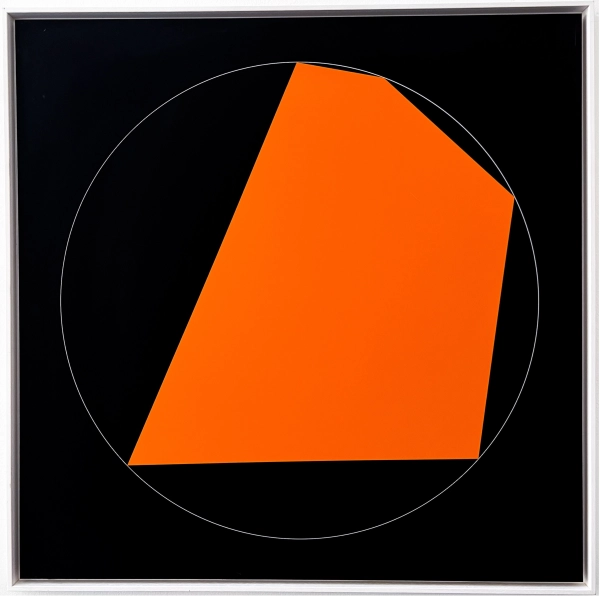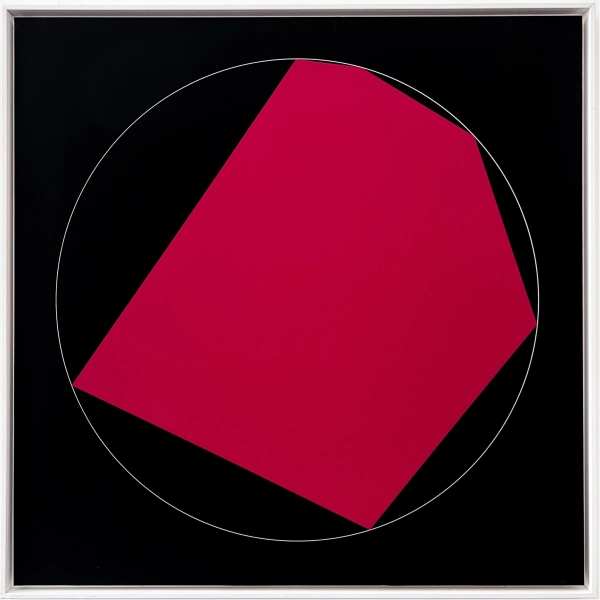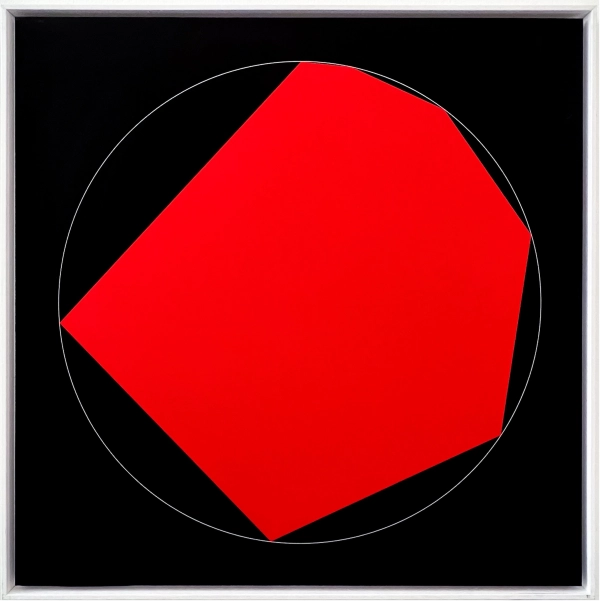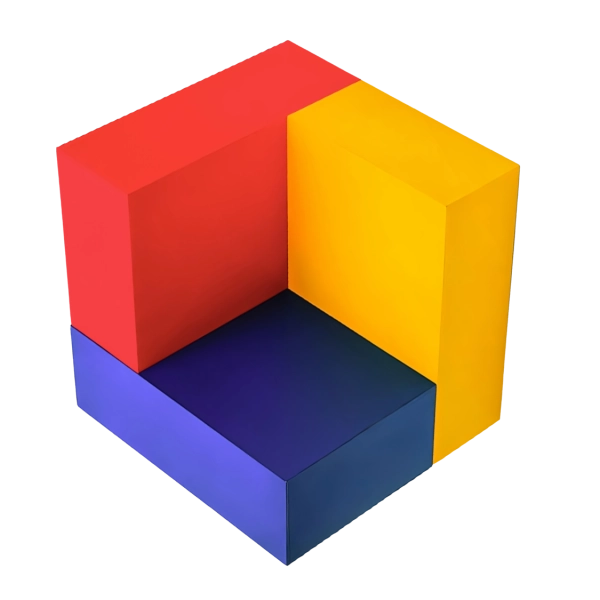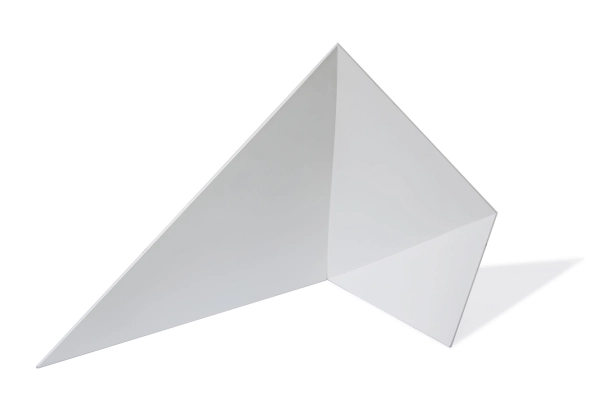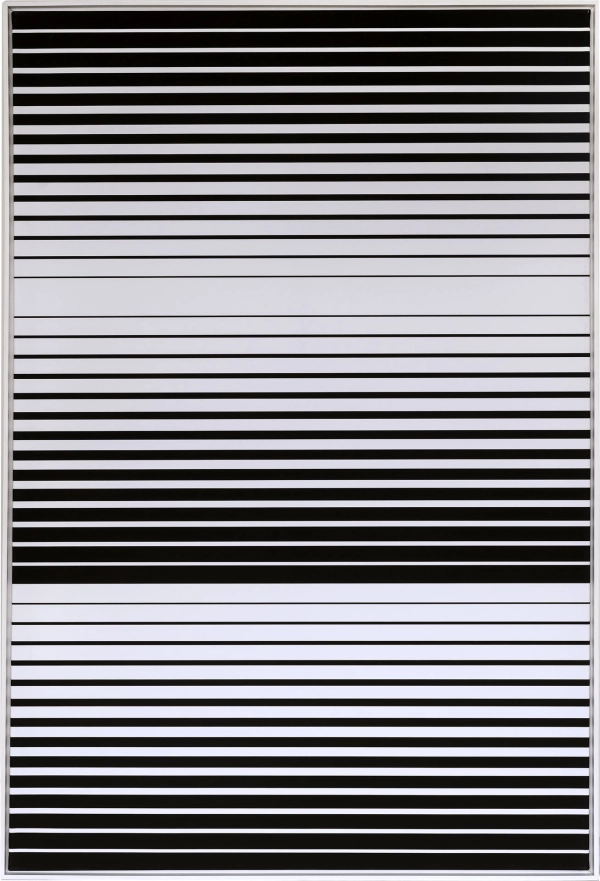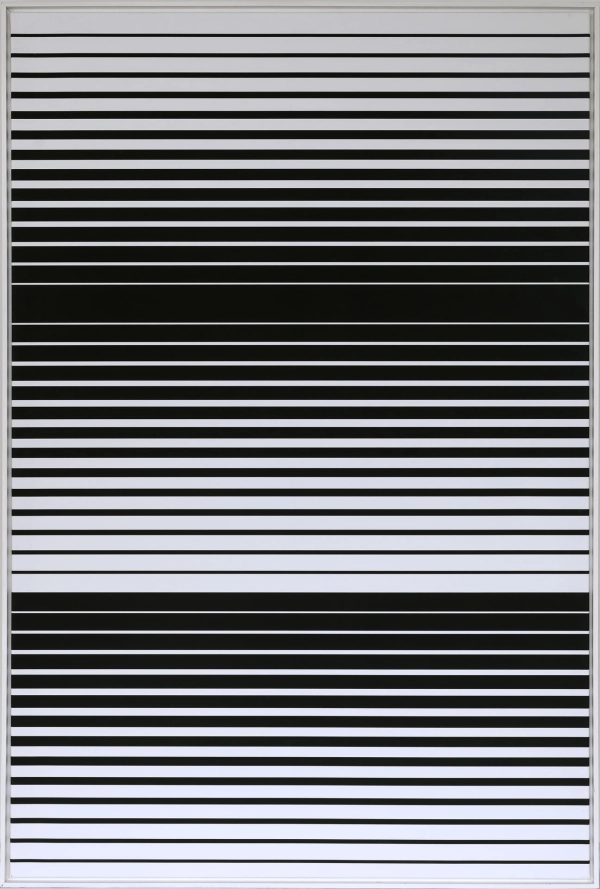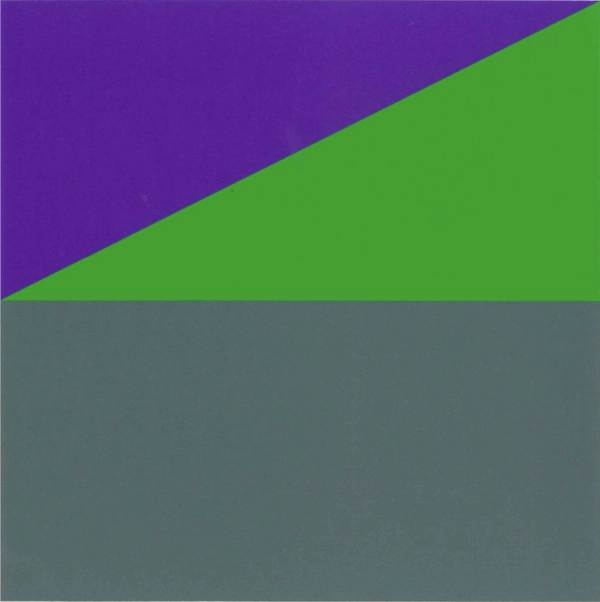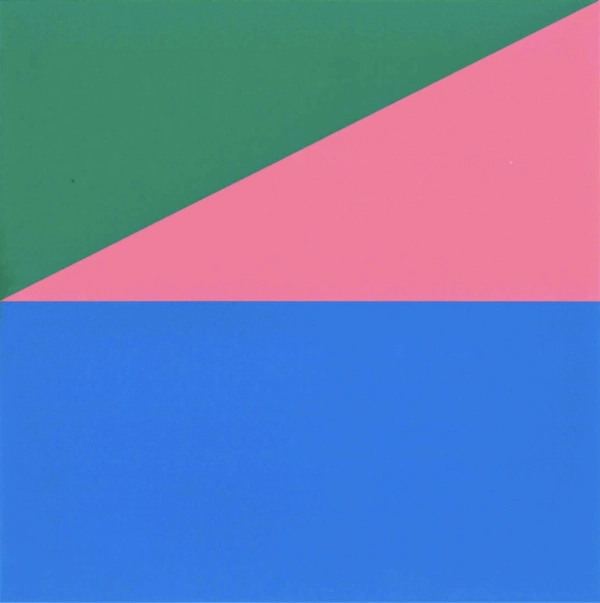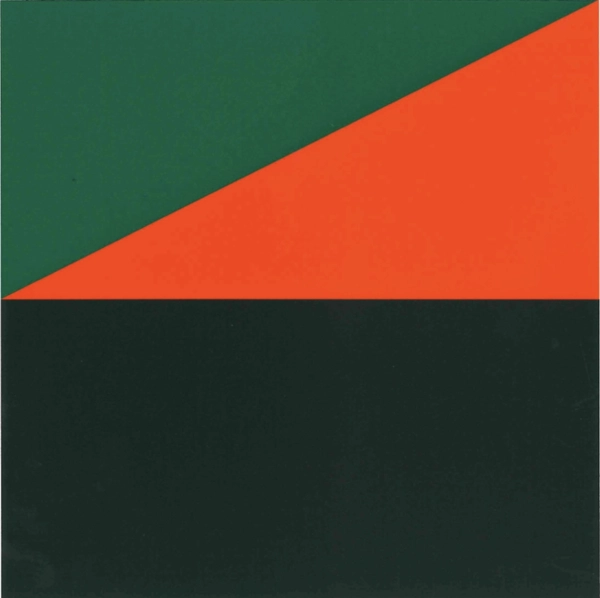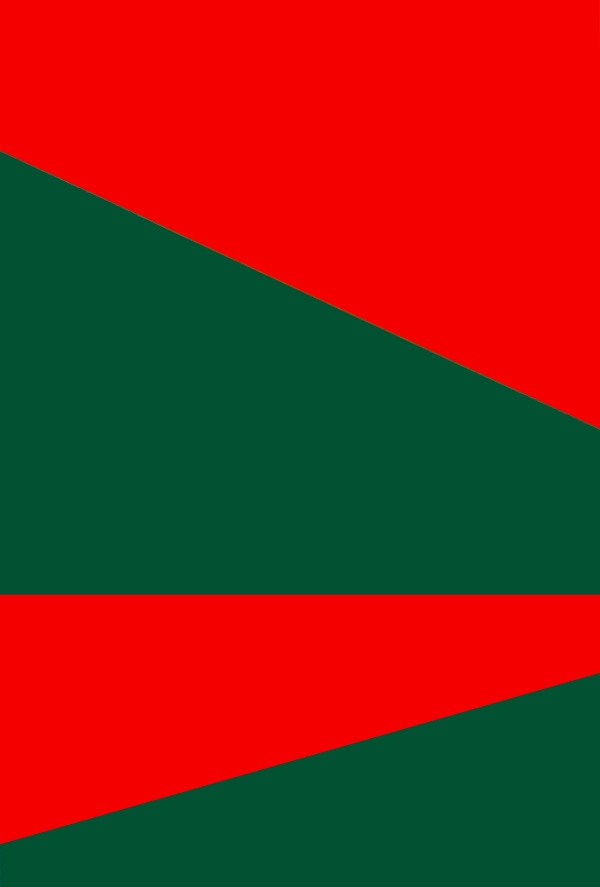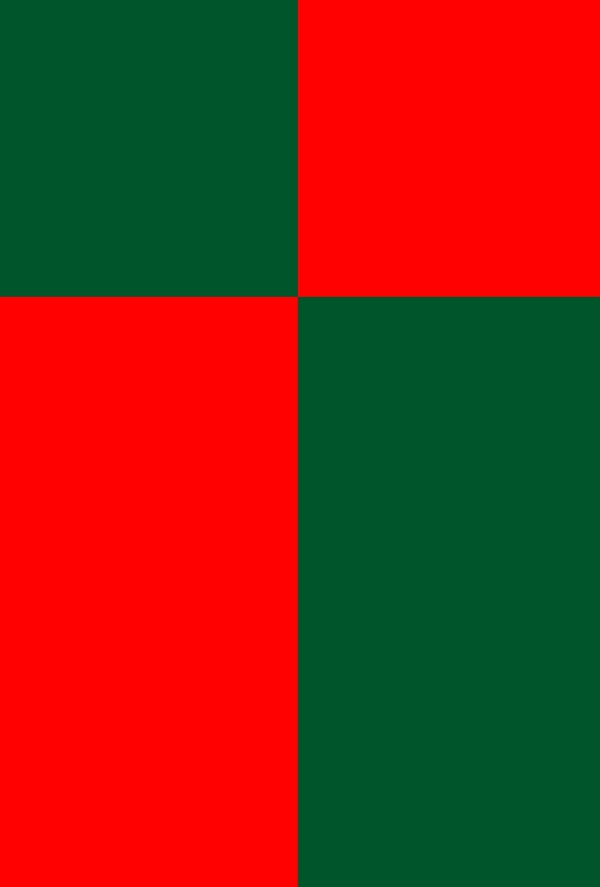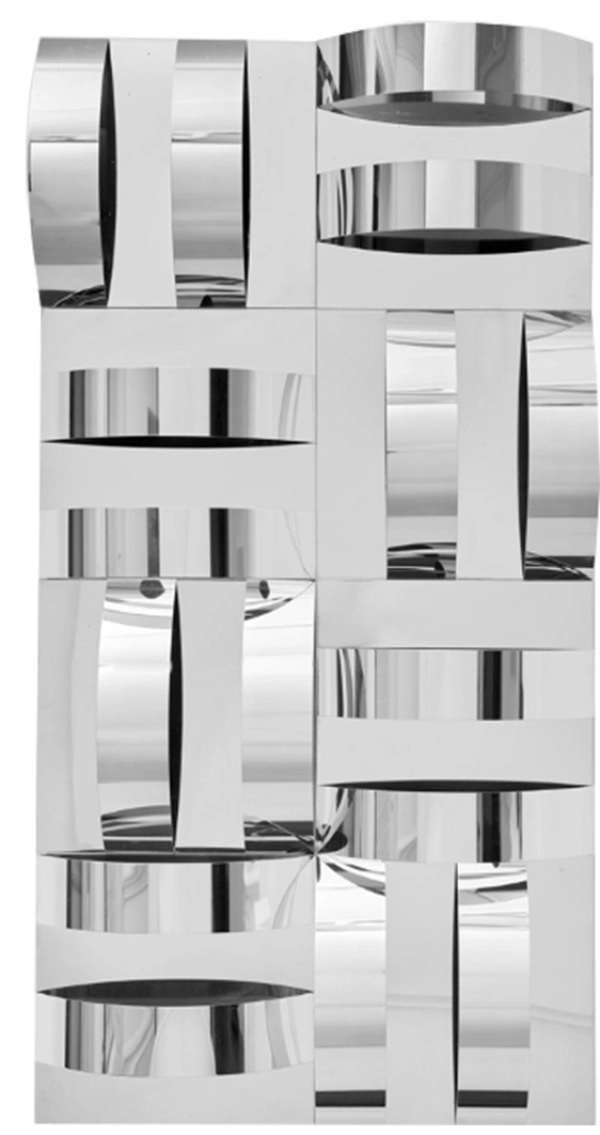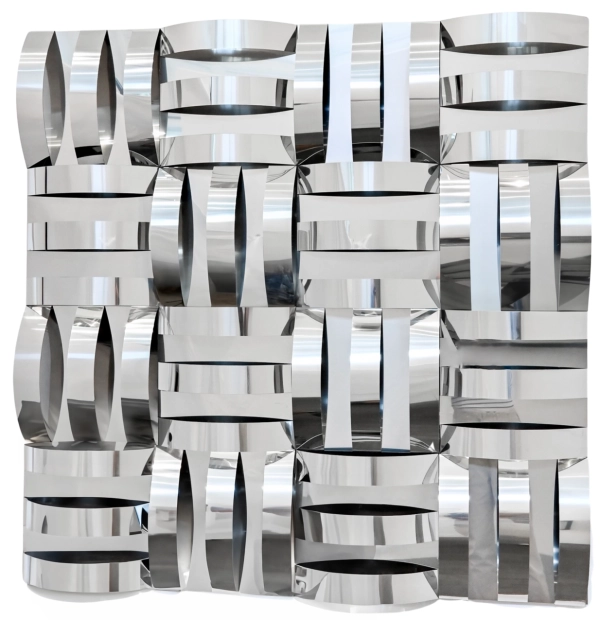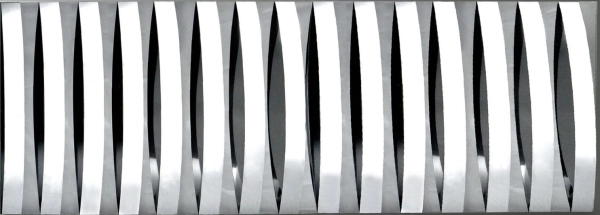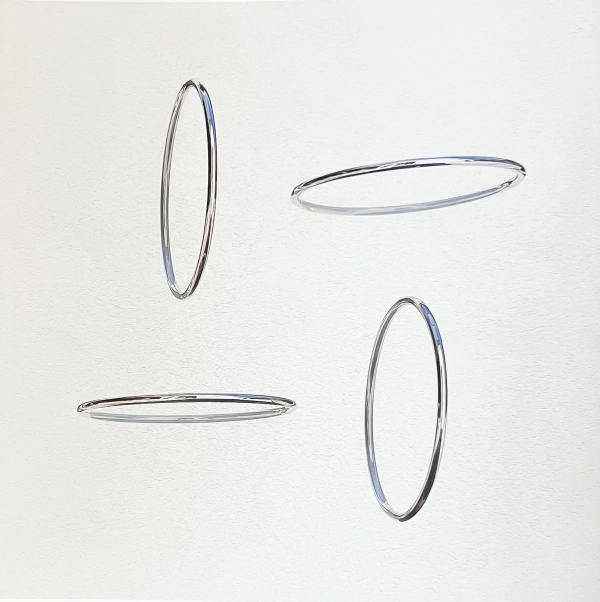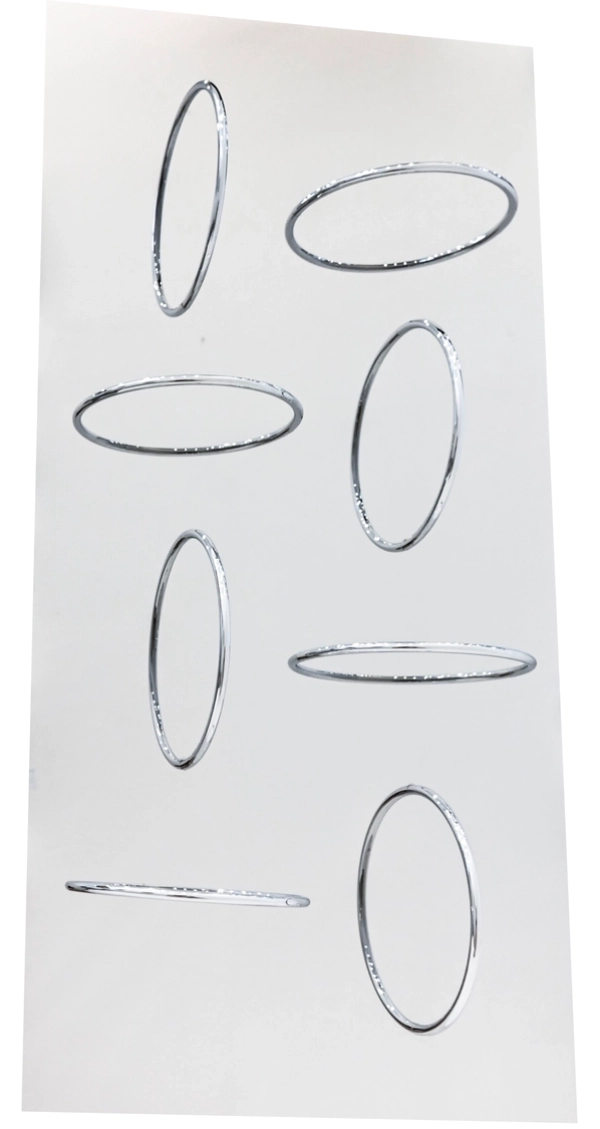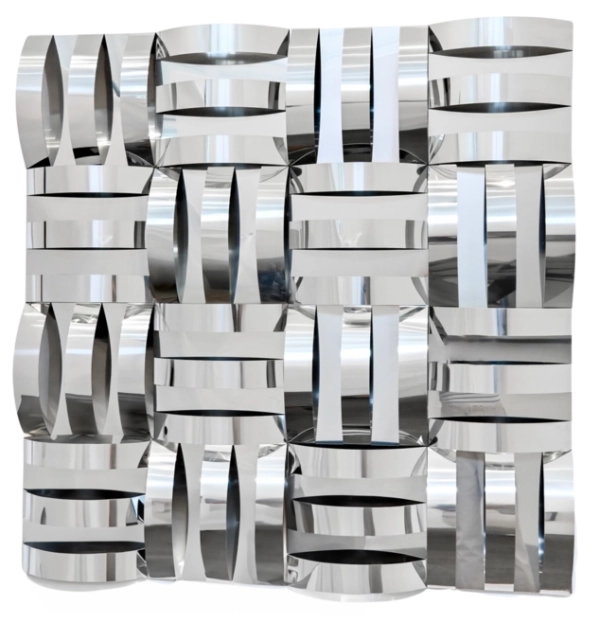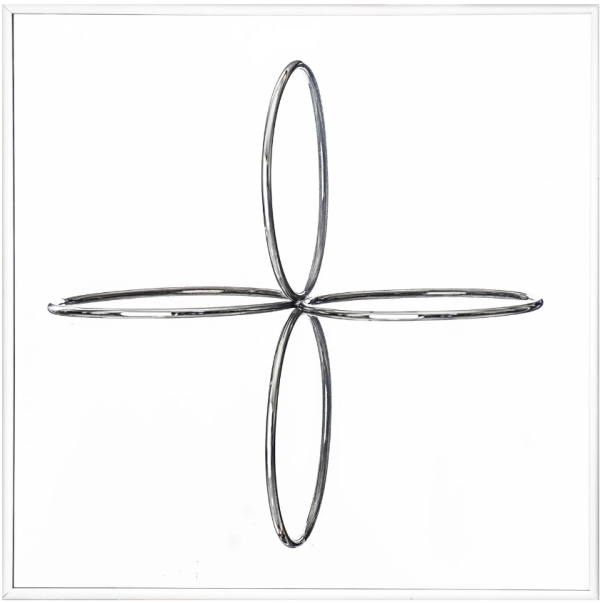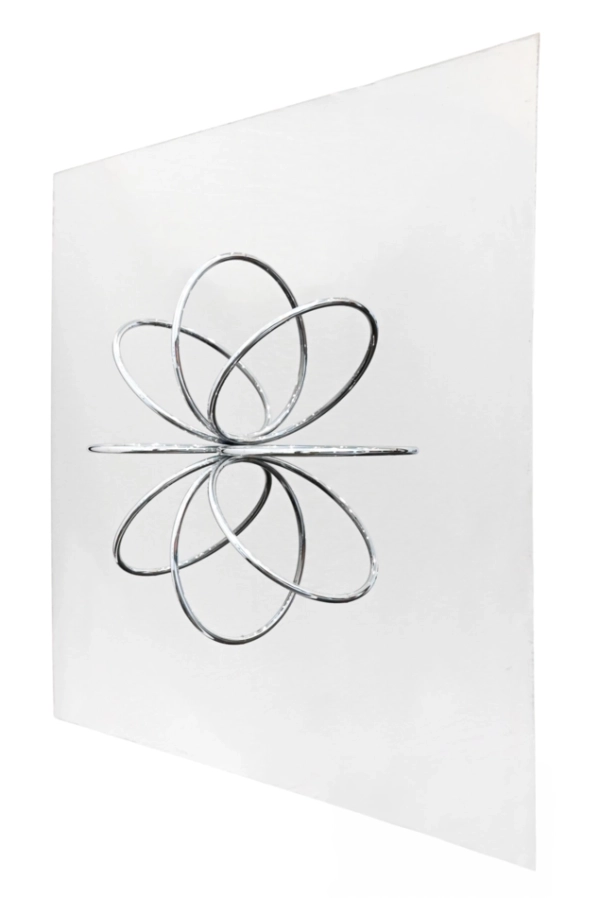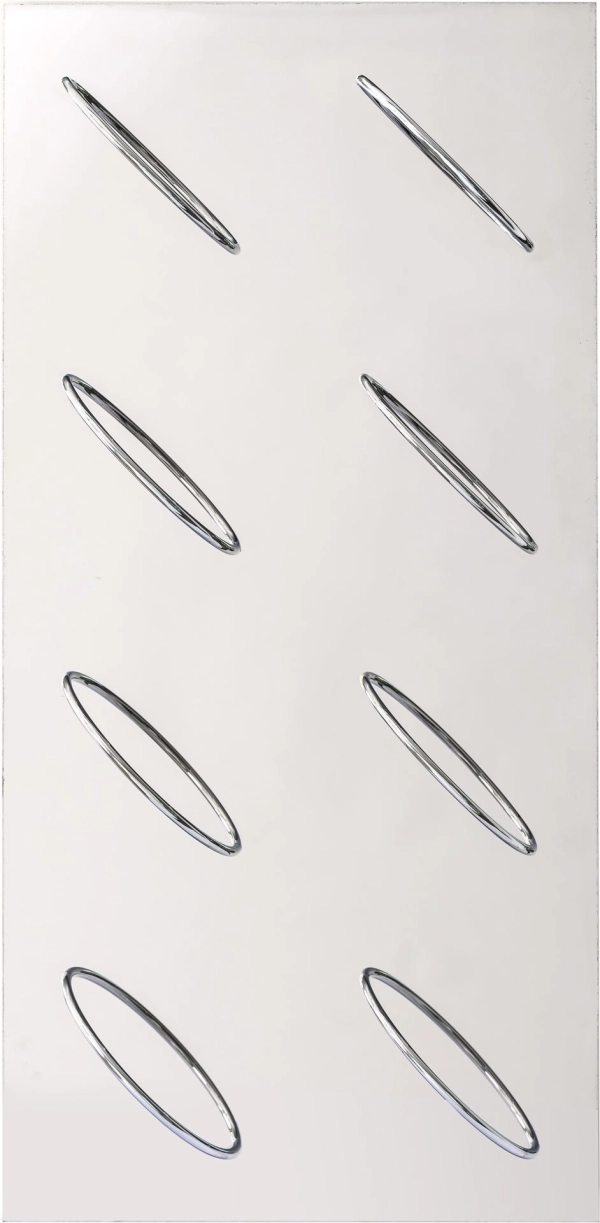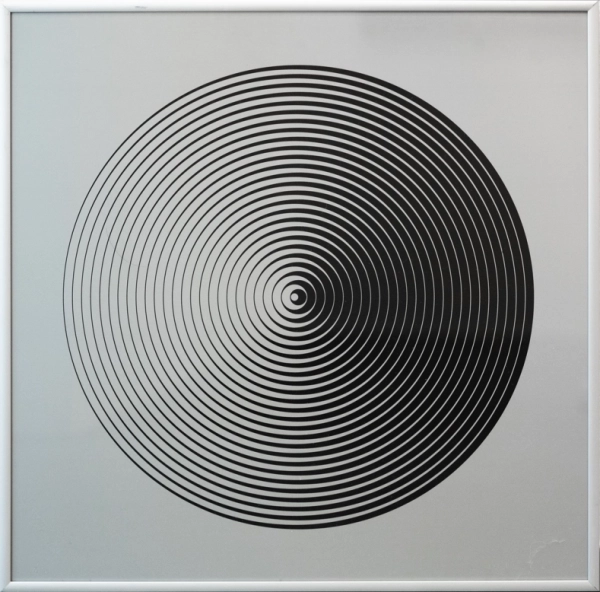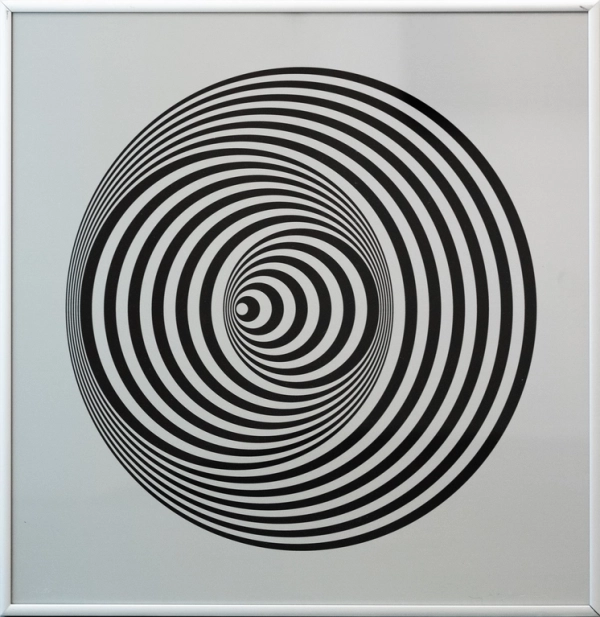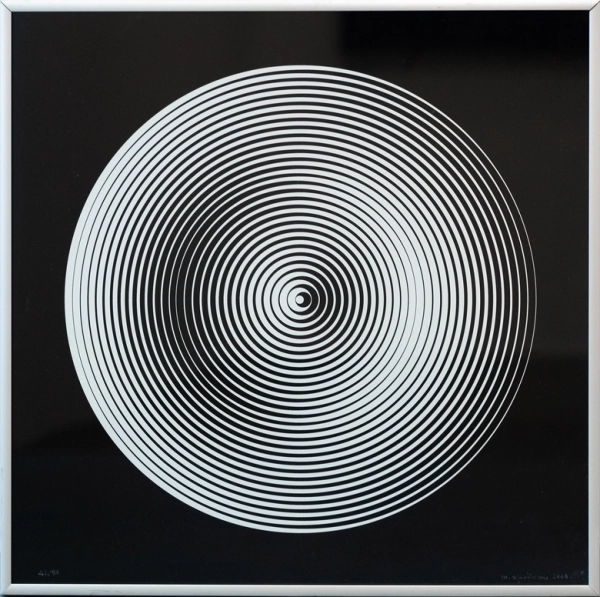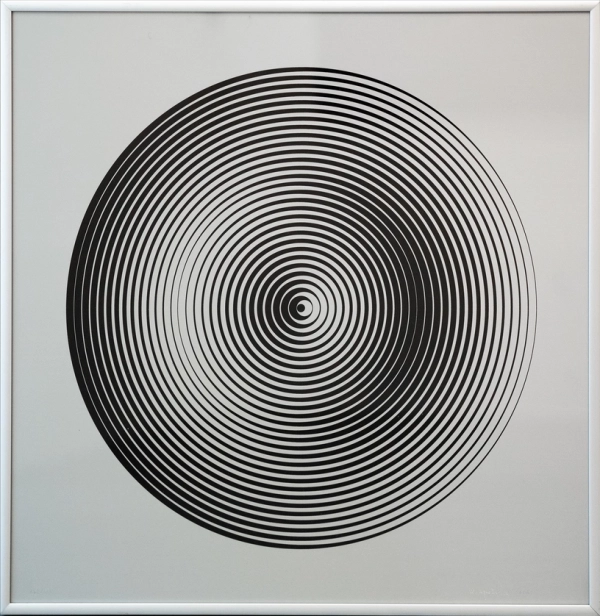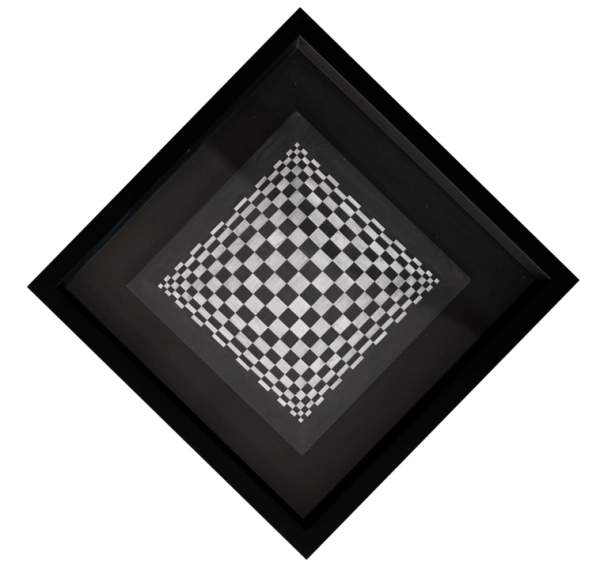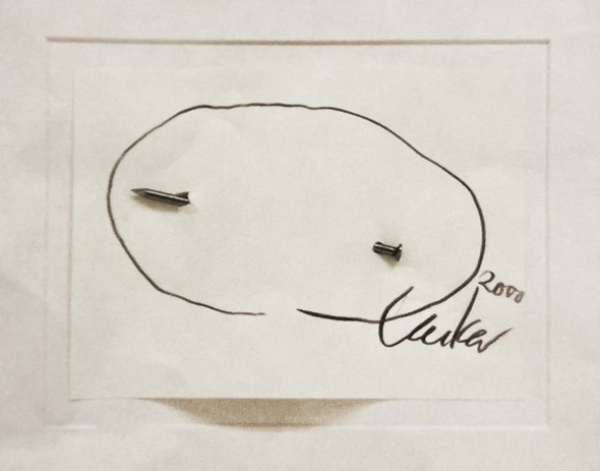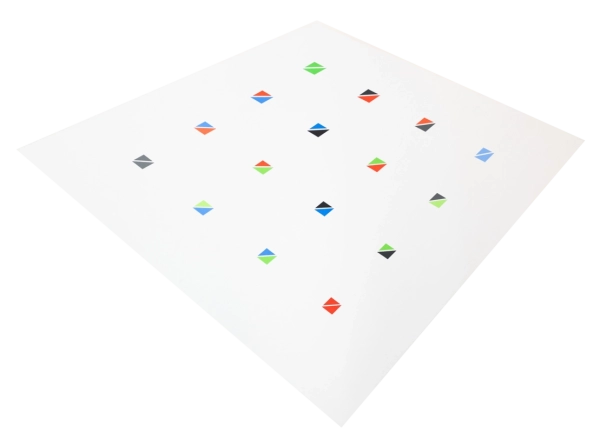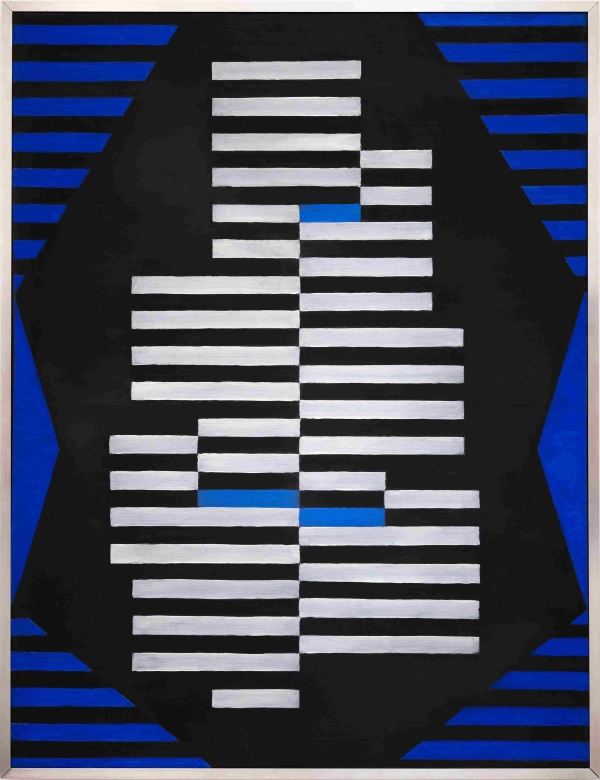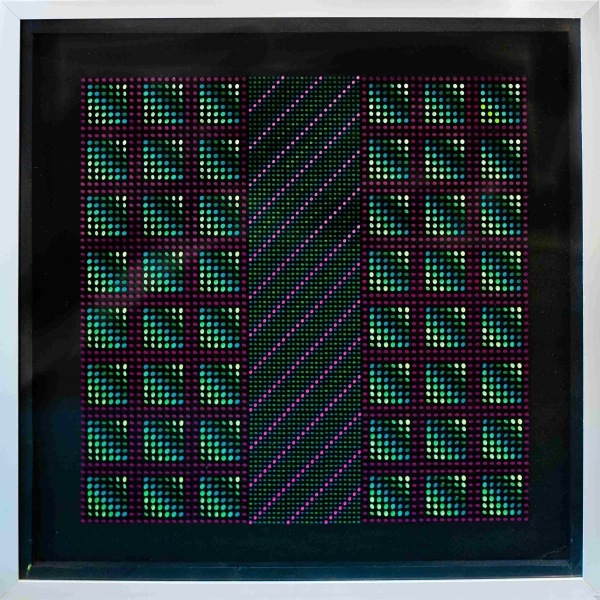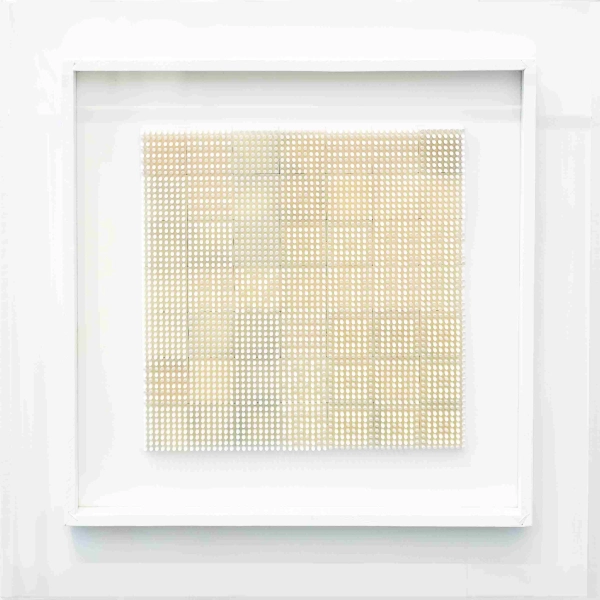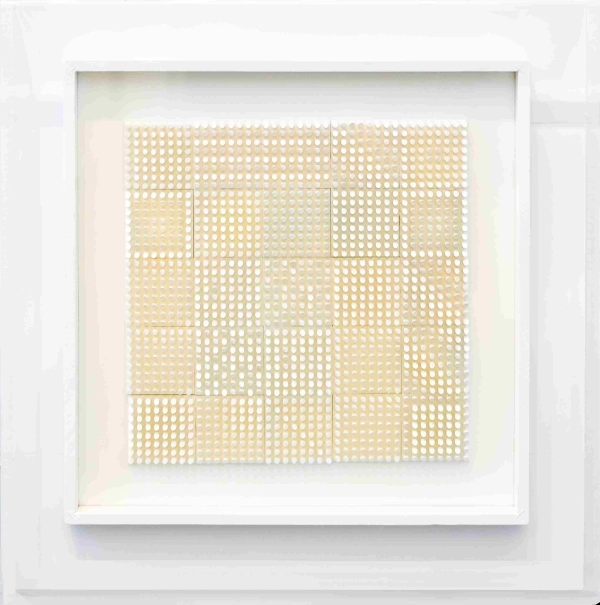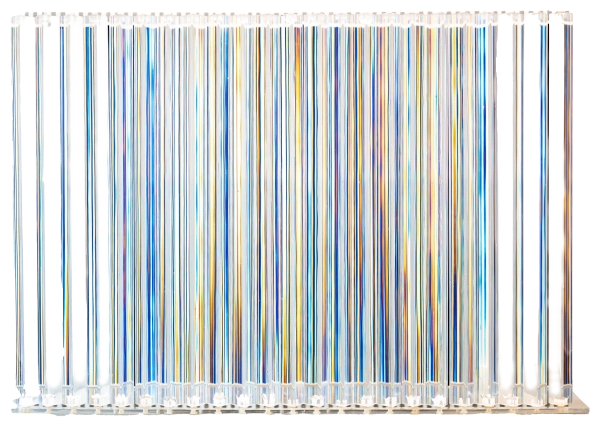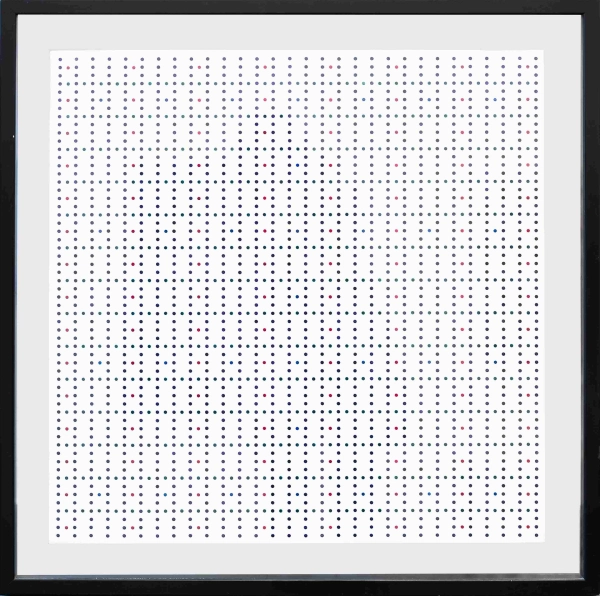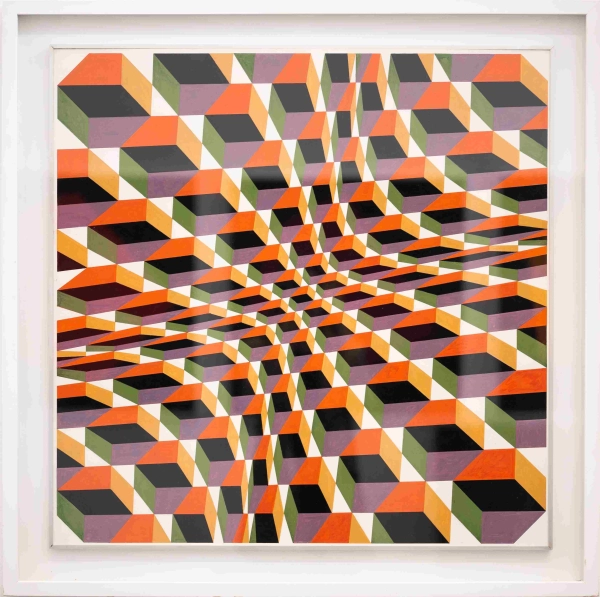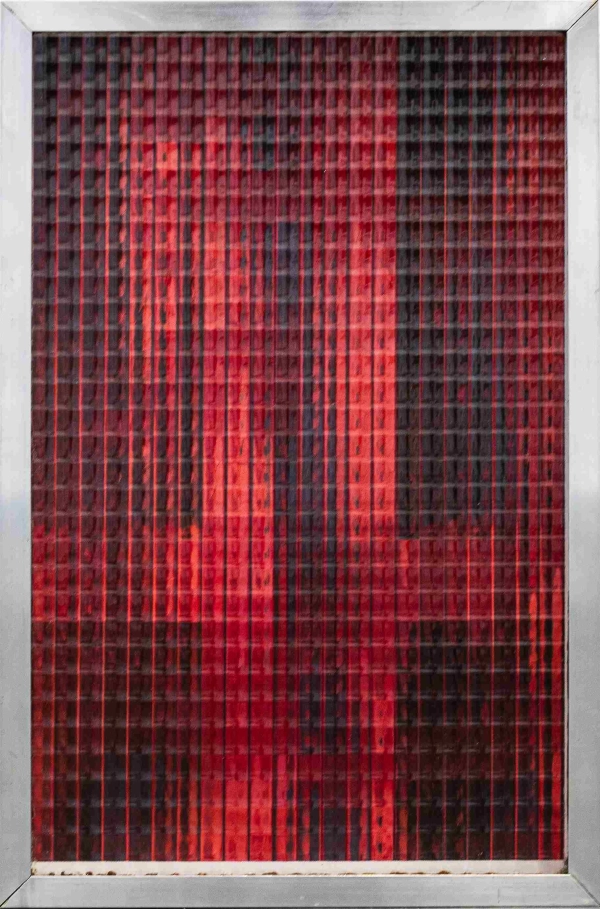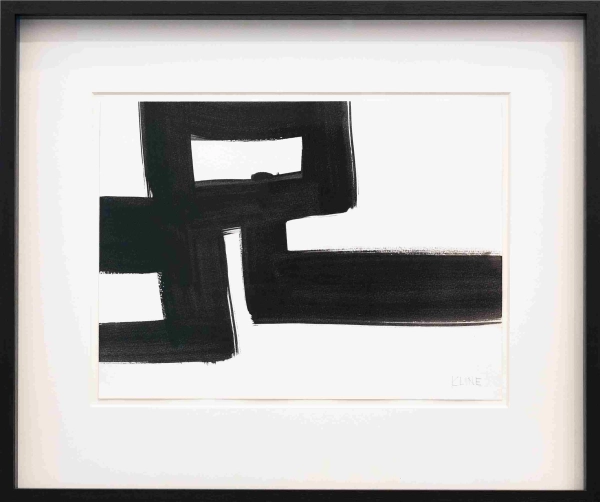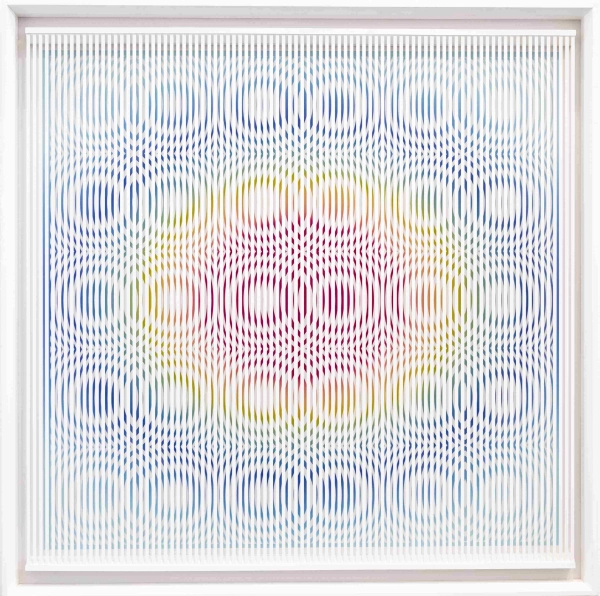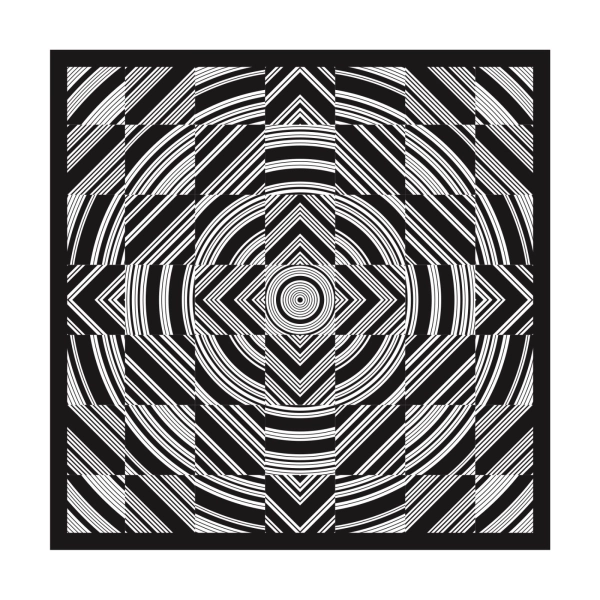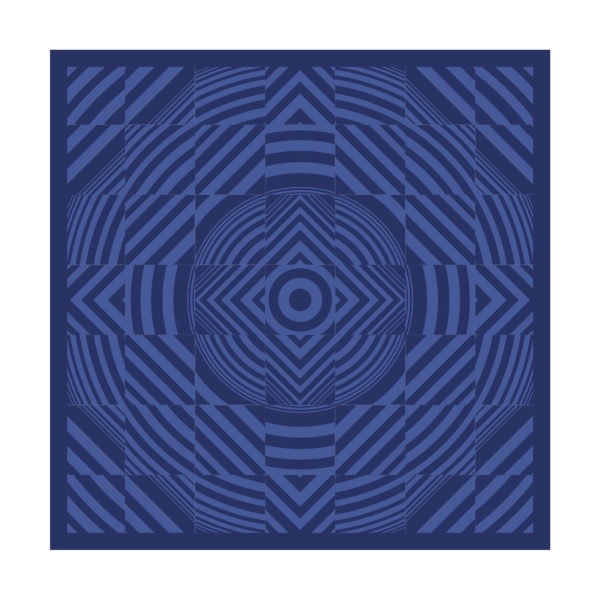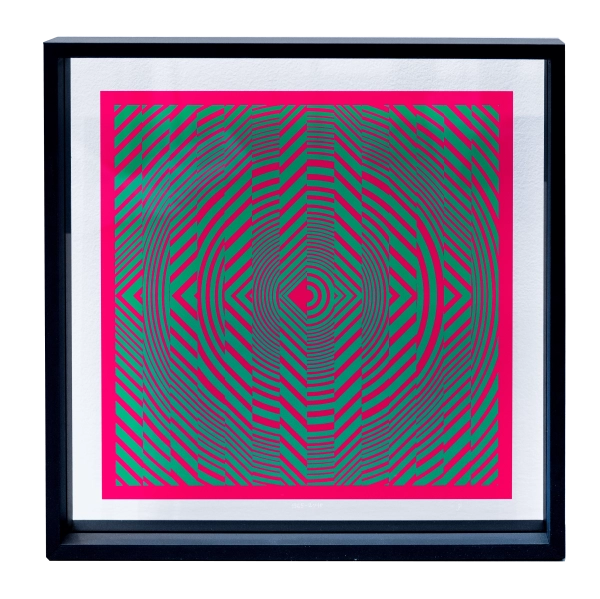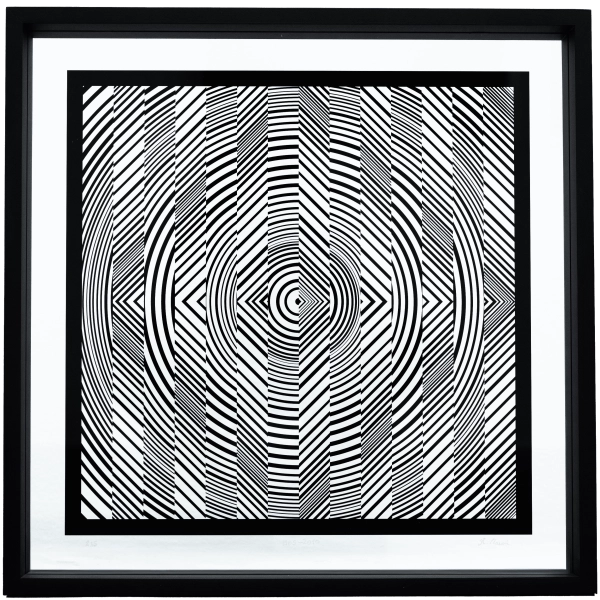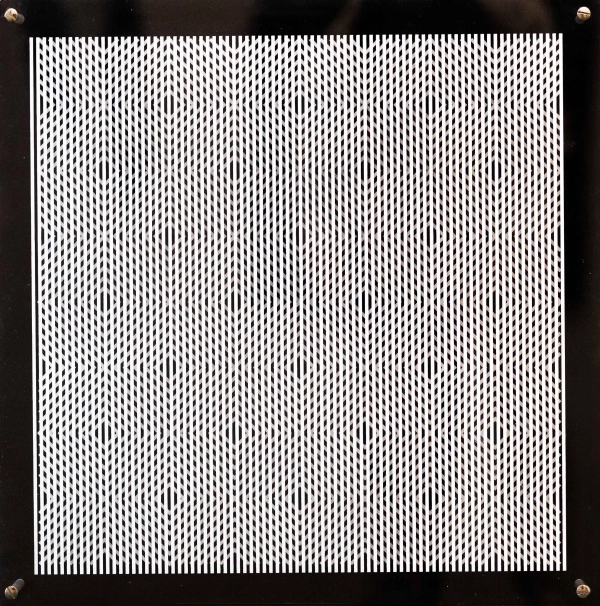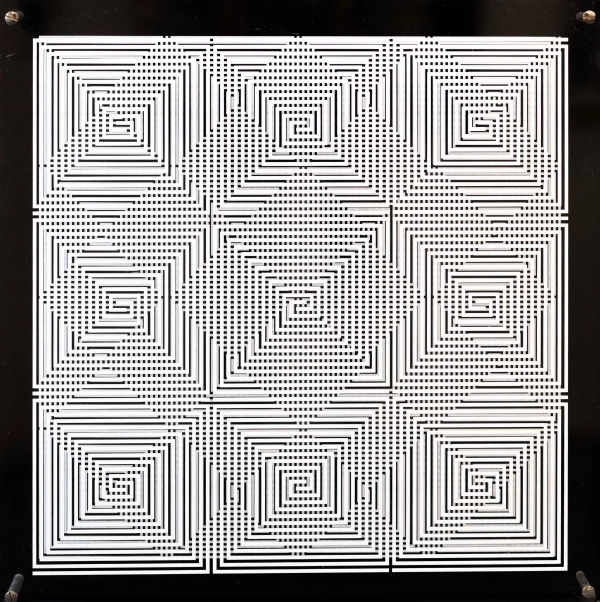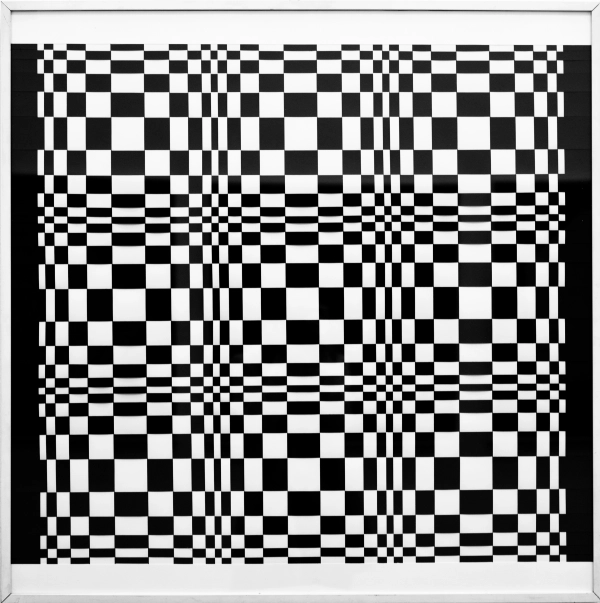Contemporary Art Gallery
- Optical
- Geometrical
- Kinetic
- Abstract
Arts
- Author: Marcello Morandini
- Medium: 3D construction, acrylglass
Configurazione Quadra Rotante
An object that works with space and material in such a way as to create a structure of perception, able to overcome the random and informal frame of the image.
- Author: Ennio Chiggio (1938 - 2020)
- Date: 1970
- Medium: Metal, black color, natural wood frame
- Size: 60x60x10 cm
SBST 801. Objekt mit Scheinbewegung
the object stimulates communication between the eye and the brain and makes use of the limits of human perception. The superposition structure requires the interaction of the viewer who, by moving or positioning in space, transforms a static object into a three-dimensional visual experience
- Author: Ludwig Wilding (1927–2010)
- Date: 1989
- Medium: serigraphy – plexiglass
- Size: 81x81x22 cm
Untitled
Massironi explored new possibilities of creation within the rules of geometric abstraction. His work is mainly characterized by an interest in light, movement, new materials, technologies and processes aimed at the reduction of visual means.
- Author: Manfredo Massironi (1937 - 2011)
- Date: 1965 - 2010
- Medium: silkscreen on the glass
- Size: 36x36 cm
Superficie satinata
The texture absorbs and reflects light and due to the metal's essence and its surface treatment it creates a complex play of reflections forming different images depending on the angle of view.
- Author: Getulio Alviani (1939–2018)
- Date: 1974
- Medium: aluminum on lacquered wood
- Size: 75x50x2 cm
Superficie satinata
the texture absorbs and reflects light and due to the metal's essence and its surface treatment it creates a complex play of reflections forming different images depending on the angle of view
- Author: Getulio Alviani (1939–2018)
- Date: 1974
- Medium: aluminum on lacquered wood
- Size: 75x50x2 cm
Superficie a testura vibratile, ¼ 4+1 quadrato di 4/4
Through experimental procedures and precise and careful design, Aviani integrates materials, geometric structures, and light and shadow expressions to depict the vibrating textural image he wants to convey, as the work's glossy texture will continue to change as the viewer's perspective changes, it repeats and stimulates the viewer's visual perception and imagination.
- Author: Getulio Alviani (1939–2018)
- Date: 1965 - 1970
- Medium: Aluminium
- Size: 60x60 cm
Superficie
The texture absorbs and reflects light and due to the metal's essence and its surface treatment it creates a complex play of reflections forming different images depending on the angle of view.
- Author: Getulio Alviani (1939–2018)
- Date: 1964 - 1986
- Medium: Aluminum on wood
- Size: 33x33x2 cm
1.2.3.4. Inscritti nel cerchio
the series of works 1.2.3.4.,…. is based on the study of colour phenomenology, resulting in structures based on mathematical formulas. The exploration of colour and surface takes various artistic forms in Alviani's conception
- Author: Getulio Alviani (1939–2018)
- Date: 1978 – 2011
- Medium: serigraphy – wood
- Size: l00xl00 cm
1.2.3.4.5. Inscritti nel cerchio
the series of works 1.2.3.4.,…. is based on the study of colour phenomenology, resulting in structures based on mathematical formulas. The exploration of colour and surface takes various artistic forms in Alviani's conception
- Author: Getulio Alviani (1939–2018)
- Date: 1978– 2011
- Medium: serigraphy – wood
- Size: l00xl00 cm
1.2.3.4.5.6. Inscritti nel cerchio
the series of works 1.2.3.4.,…. is based on the study of colour phenomenology, resulting in structures based on mathematical formulas. The exploration of colour and surface takes various artistic forms in Alviani's conception
- Author: Getulio Alviani (1939–2018)
- Date: 1978– 2011
- Medium: serigraphy – wood
- Size: l00xl00 cm
1.2.3.4.5.6.7. Inscritti nel cerchio
the series of works 1.2.3.4.,…. is based on the study of colour phenomenology, resulting in structures based on mathematical formulas. The exploration of colour and surface takes various artistic forms in Alviani's conception
- Author: Getulio Alviani (1939–2018)
- Date: 1978– 2011
- Medium: serigraphy – wood
- Size: l00xl00 cm
1.2.3.
the series of works 1.2.3.4.,…. is based on the study of colour phenomenology, resulting in structures based on mathematical formulas. The exploration of colour and surface takes various artistic forms in Alviani's conception
- Author: Getulio Alviani (1939–2018)
- Date: 1978
- Medium: sculptural object – angled steel sheet, acrylic
- Size: 50x57x30 cm
B I. Positivo - negativo e suo pappio
the programming of lines, shapes and chromes and reassembly of structures such as the “pneumatic spaces” that concentrate on units over spaces and mobility. This series includes textiles with kinetic-optical designs, which Germana Marucelli used to create the iconic dresses of the 60s-70s
- Author: Getulio Alviani (1939–2018)
- Date: 1962– 2015
- Medium: mixed media – canvas
- Size: 120x180 cm
B II. Positivo - negativo e suo pappio
the programming of lines, shapes and chromes and reassembly of structures such as the “pneumatic spaces” that concentrate on units over spaces and mobility. This series includes textiles with kinetic-optical designs, which Germana Marucelli used to create the iconic dresses of the 60s-70s
- Author: Getulio Alviani (1939–2018)
- Date: 1962– 2015
- Medium: mixed media – canvas
- Size: 120x180 cm
Tecnica mista
Alviani’s prints had an independent existence, not merely transferring other significant works or subjects to paper. Each piece addressed plasticity issues, solvable only through its specific technique. Alviani sought optimal results through screen printing for color and black-and-white photo-mechanical lithography for line work.
- Author: Getulio Alviani (1939–2018)
- Date: 1978 - 2011
- Medium: Silkscreen on canvas
- Size: 100x100 cm
Tecnica mista
Alviani’s prints had an independent existence, not merely transferring other significant works or subjects to paper. Each piece addressed plasticity issues, solvable only through its specific technique. Alviani sought optimal results through screen printing for color and black-and-white photo-mechanical lithography for line work.
- Author: Getulio Alviani (1939–2018)
- Date: 1978 - 2011
- Medium: Silkscreen on canvas
- Size: 100x100 cm
Tecnica mista
Alviani’s prints had an independent existence, not merely transferring other significant works or subjects to paper. Each piece addressed plasticity issues, solvable only through its specific technique. Alviani sought optimal results through screen printing for color and black-and-white photo-mechanical lithography for line work.
- Author: Getulio Alviani (1939–2018)
- Date: 1978 - 2011
- Medium: Silkscreen on canvas
- Size: 100x100 cm
Fifty-fifty
Alviani’s prints had an independent existence, not merely transferring other significant works or subjects to paper. Each piece addressed plasticity issues, solvable only through its specific technique. Alviani sought optimal results through screen printing for color and black-and-white photo-mechanical lithography for line work.
- Author: Getulio Alviani (1939–2018)
- Date: 1962 - 2000
- Medium: Silkscreen on the wood
- Size: 100x150 cm
Fifty-fifty
Alviani’s prints had an independent existence, not merely transferring other significant works or subjects to paper. Each piece addressed plasticity issues, solvable only through its specific technique. Alviani sought optimal results through screen printing for color and black-and-white photo-mechanical lithography for line work.
- Author: Getulio Alviani (1939–2018)
- Date: 1962 - 2000
- Medium: Silkscreen on the wood
- Size: 100x150 cm
Rilievo speculare a elementi curvi
the chromostructure of line, geometry and mirroring used to create optical kinetic art through movement and reflection of the surroundings is Alviani's response to the public's inclusion in "environments" in which the observer can personally modify the work, activating it through movement
- Author: Getulio Alviani (1939–2018)
- Date: 1962
- Medium: highly-polished stainless steel sheet
- Size: 120x60x10 cm
Rilievo speculare ad elementi curvi I.
the chromostructure of line, geometry and mirroring used to create optical kinetic art through movement and reflection of the surroundings is Alviani's response to the public's inclusion in "environments" in which the observer can personally modify the work, activating it through movement
- Author: Getulio Alviani (1939–2018)
- Date: 1962
- Medium: highly-polished stainless steel sheet
- Size: 120x120 cm
Rilievo speculare a elementi curvi
the chromostructure of line, geometry and mirroring used to create optical kinetic art through movement and reflection of the surroundings is Alviani's response to the public's inclusion in "environments" in which the observer can personally modify the work, activating it through movement
- Author: Getulio Alviani (1939–2018)
- Date: 1962
- Medium: highly-polished stainless steel sheet
- Size: 120x120x10 cm
Rilievo speculare a elementi curvi
the chromostructure of line, geometry and mirroring used to create optical kinetic art through movement and reflection of the surroundings is Alviani's response to the public's inclusion in "environments" in which the observer can personally modify the work, activating it through movement
- Author: Getulio Alviani (1939–2018)
- Date: 1962
- Medium: highly-polished stainless steel sheet
- Size: 60x180x10 cm
No name
The work depicts metal reliefs with alternating color sequences. She exploited the illusionistic visual experiments to create works that seemed to physically draw the viewer into the painting, in which the flat surface had virtually disappeared.
- Author: Marina Apollonio (1940)
- Date: 2008
- Medium: Screenprint on enameled aluminum
- Size: 50x50 cm
No name
The work depicts metal reliefs with alternating color sequences. She exploited the illusionistic visual experiments to create works that seemed to physically draw the viewer into the painting, in which the flat surface had virtually disappeared.
- Author: Marina Apollonio (1940)
- Date: 2008
- Medium: Screenprint on enameled aluminum
- Size: 50x50 cm
No name
The work depicts metal reliefs with alternating color sequences. She exploited the illusionistic visual experiments to create works that seemed to physically draw the viewer into the painting, in which the flat surface had virtually disappeared.
- Author: Marina Apollonio (1940)
- Date: 2008
- Medium: Screenprint on enameled aluminum
- Size: 50x50 cm
No name
The work depicts metal reliefs with alternating color sequences. She exploited the illusionistic visual experiments to create works that seemed to physically draw the viewer into the painting, in which the flat surface had virtually disappeared.
- Author: Marina Apollonio (1940)
- Date: 2008
- Medium: Screenprint on enameled aluminum
- Size: 50x50 cm
No name
In the 1950s, influenced by Eastern philosophy and Gregorian chanting, he began a ritual of hammering nails. These materials signify protection and creation to the artist, who remembers nailing planks over the windows of his home to deter Soviet troops after the Second World War.
- Author: Günther Uecker (1930)
- Date: 2000
- Medium: Nail and pencil on paper
- Size: 28,5x38,5 cm
Diagonal-permutation-II
It is possible to see geometric objects and distributed surfaces, which, however, confuse the viewer with their specific spatiality, perspective and irregular shape. This work becomes a kind of symbolic representative sign of this contemplative artist.
- Author: Hans Jörg Glattfelder (1939)
- Date: 1997
- Medium: Acrylic on canvas on wood
- Size: 70x57x62x80 cm
CILRVBGN
Costalonga is an innovator of optart and kinetic art. Interested in color theory, Costalonga's paintings gradually expanded into three-dimensional forms with complex surfaces that produced scintillating visual effects.
- Author: Franco Costalonga (1933 - 2019)
- Date: 1974
- Medium: Acrylic, wood, MDF and plexiglass
- Size: 63x63x5 cm
CMG Bianco
Costalonga is an innovator of optart and kinetic art. Interested in color theory, Costalonga's paintings gradually expanded into three-dimensional forms with complex surfaces that produced scintillating visual effects.
- Author: Franco Costalonga (1933 - 2019)
- Date: 1974
- Medium: Acrylic, wood, MDF and plexiglass
- Size: 50,5x50,5x10 cm
CMG Bianco
Costalonga is an innovator of optart and kinetic art. Interested in color theory, Costalonga's paintings gradually expanded into three-dimensional forms with complex surfaces that produced scintillating visual effects.
- Author: Franco Costalonga (1933 - 2019)
- Date: 1974
- Medium: Acrylic, wood, MDF and plexiglass
- Size: 50,5x50,5x10 cm
Prevalence
Points, first monochrome, then coloured, arranged on the canvas or board in an order that follows a mathematical definition. The result is highly poetic and absolutely in line with the experiments that many artists have carried out since the 1960s.
- Author: Antonio Scaccabarozzi (1936 - 2008)
- Date: 1976
- Medium: Acrylic on canvas
- Size: 60x60 cm
Maquette zu Sylvesterbild
Adrian is considered to be one of the pioneers of media art focusing on kinetic objects, anti-film and computer art. He evoked complex, reciprocal movements like physical waves or concentric circles.
- Author: Marc Adrian (1930 - 2008)
- Date: 1977
- Medium: Oil on canvas behind Edelitglass
- Size: 48.5×32×7 cm
No name
Although Kline's paintings look as if they were executed in a spontaneous burst of activity, they were often painstakingly pre- planned through preliminary studies. Despite the fact that Kline's paintings look like variations on Asian calligraphy, the artist denied this influence.
- Author: Franz Kline (1910 - 1962)
- Date: 1955
- Medium: Ink on a paper
- Size: 29x40 cm
Untitled
Massironi explored new possibilities of creation within the rules of geometric abstraction. His work is mainly characterized by an interest in light, movement, new materials, technologies and processes aimed at the reduction of visual means.
- Author: Manfredo Massironi (1937 - 2011)
- Date: 1965 - 2010
- Medium: silkscreen on the glass
- Size: 36x36 cm
Untitled
Massironi explored new possibilities of creation within the rules of geometric abstraction. His work is mainly characterized by an interest in light, movement, new materials, technologies and processes aimed at the reduction of visual means.
- Author: Manfredo Massironi (1937 - 2011)
- Date: 1965 - 2010
- Medium: silkscreen on the glass
- Size: 36x36 cm
Untitled
Massironi explored new possibilities of creation within the rules of geometric abstraction. His work is mainly characterized by an interest in light, movement, new materials, technologies and processes aimed at the reduction of visual means.
- Author: Manfredo Massironi (1937 - 2011)
- Date: 1965 - 2010
- Medium: silkscreen on the glass
- Size: 36x36 cm
Untitled
Massironi explored new possibilities of creation within the rules of geometric abstraction. His work is mainly characterized by an interest in light, movement, new materials, technologies and processes aimed at the reduction of visual means.
- Author: Manfredo Massironi (1937 - 2011)
- Date: 1965 - 2010
- Medium: silkscreen on the glass
- Size: 36x36 cm
INTERFERENZA LINEARE 14
Informal gesture is overcome in order to adhere to more structured formal compositions in a constructivist sense with a greater focus on form psychology.
- Author: Ennio Chiggio (1938 - 2020)
- Date: 1966 - 2014
- Medium: black and white PVC sheet + laser engraved plexiglass sheet
- Size: 45x45x5 cm
LINEAR INTERFERENCE 14.3-4X4/moduct giano
Informal gesture is overcome in order to adhere to more structured formal compositions in a constructivist sense with a greater focus on form psychology.
- Author: Ennio Chiggio (1938 - 2020)
- Date: 1966 - 2014
- Medium: black and white PVC sheet + laser engraved plexiglass sheet
- Size: 45x45x5 cm
Komart Gallery
Komart Gallery was founded in 1998 in Bratislava. Its exhibition programme focuses exclusively on optical, kinetic and geometric abstraction. Since 2001, the Gallery had worked closely with the Milan Dobes Museum in Bratislava. In 2011, the Gallery had opened its flagstore in Berlin. Now the Gallery is open to all who trust in the values of contemporary art also in Prague.
GALERIE KOMART s.r.o.
Gallery: Salvátorská 932/6, 110 00 Praha 1
Office: Karolinská 707/7, 186 00 Praha 8
IN: 19232870
Contact: gallery@gallerykomart.cz
